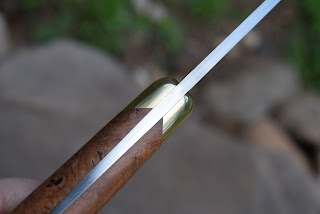Hard to know where all the time goes. I think I have a lot of time to get things done, but now Fall is long over and I only got half of what I wanted done. I did finish 3 seaxes this Fall,
This first one a classic Baltic area viking age knife. The blade is 6.25" (15.8cm), and the overall length is 11.5" (29cm).
The blade is a multibar pattern-weld (damascus) from 3 bars. The edge is 423 layers of 1095 & 15N20 steel in a pool & eye pattern. The middle bar is a loose twist of these same two steels, and the the spine is old wrought iron from my mom's 1815 farm.
The handle is caribou antler left natural, and two unique bronze fittings shaped to the antler. The sheath is top grain tooling leather with bronze fittings stamped with geometric decorations. I've tried for a slightly weathered look on the whole piece.
The second seax is a bit bigger. The blade is 10.5" long. Overall length of the seax is 17". The blade shape owes a bit to the leuku of the sami people, but definitely falls within the range of blade shapes produced in scandinavia during the viking age. The blade is made from the same billet of damascus as the first blade.
The handle is torrified maple (torrified wood has been heated in a non-oxygen atmosphere to induce chemical changes that make it resistant to moisture) with 4 coats of waterlox varnish. It has a Urnes style dragon carved on both sides. The fittings are hand cast bronze.
The sheath is done in a baltic style. The handle section of the sheath has been lined with merino wool felt for a nice secure fit to the seax. The fittings are hand stamped 20ga. bronze sheet, and the suspension rings are cast bronze.
Ironically I was trying to make simpler seaxes with less decoration so they would be less expensive. I did ok on the first one, kinda blew it on the second one by adding the handle carvings. On this one I just gave up and did what I felt like doing. :-\
This seax is made in an Anglo-Saxon style appropriate to about 600 AD to 1100 AD. I tried to keep it within bounds for a historical piece, but it is not a reproduction of any particular seax.
The blade is 14" long. It is a triple bar pattern-weld using the same configuration as the other two, but the twist in the middle bar is a bit tighter on this blade. Overall length is is 21" (533mm) and weighs 1 lb. 4.59 oz.
The handle is made from stabilized maple, which is maple saturated with acrylic resin. While certainly not historical, it provides a harder handle that will withstand much more abuse, and will have negligible swelling and shrinkage due to humidity changes. As a bonus, the stabilizing is invisible so no one will ever know if you don't tell them.
The handle is carved on both sides with a dragon that has a garnet set into the handle for it's eye. The handle also has two coats of Waterlox varnish applied to it to seal any tiny imperfections and further weatherproof the handle. The fittings are bronze, made from carvings of mine using the lost wax casting process.
I also managed to make some jewelry, but that's for another post.




































